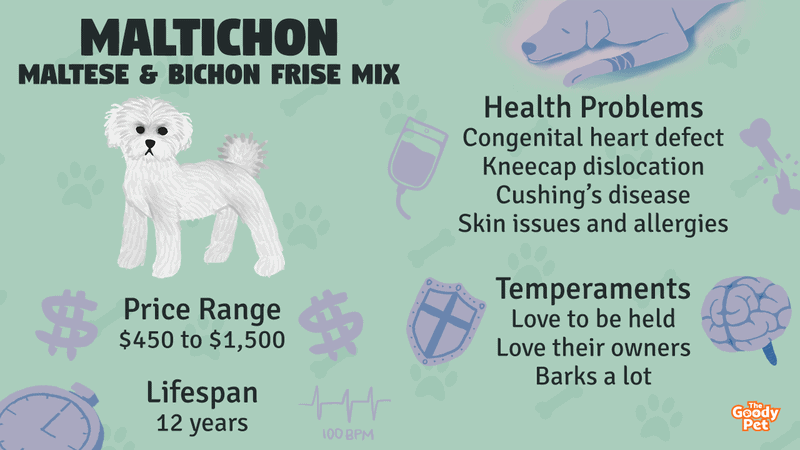The Maltese Terrier and Bichon Frise mix, otherwise more commonly known as the Maltichon, is one of the most well-known mixed breed dogs. They are a gentle yet playful and affectionate dog breed that does well in pretty much any setting.
The Maltichon also doesn’t need that much exercise as well. However, just because these sweet and intelligent creatures are small and relatively low-maintenance, that doesn’t mean that it’s easy to take care of them.
If you don’t exercise proper caution and care when playing with these adorable pooches, nor have working knowledge on how to take proper care of one, your Maltichon could be at risk of injury, among other things.
With that said, like any other furry companion, a Maltichon will need the right kind of care, and we’ll show you exactly just how to do that below.
But, before we begin, let’s first take a look at what a Maltichon is.
What Is A Maltese Bichon Frise Mix?
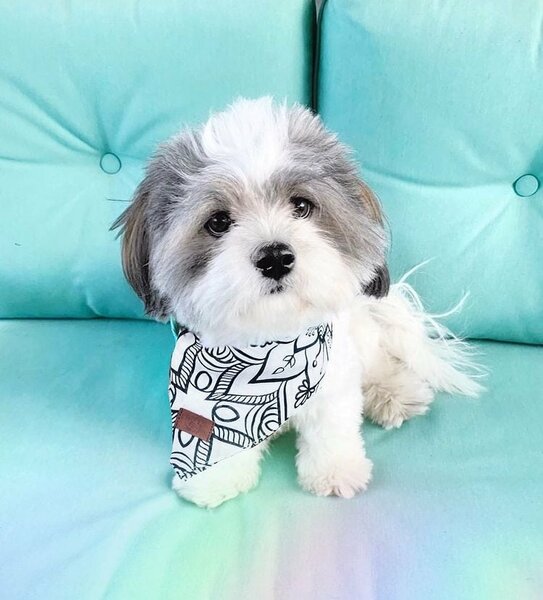
Both the Bichon Frise and Maltese belong to the same canine group.
Both dog breeds also share the same lineage and ancestry. In fact, both even have similar characteristics.
In particular, both are often usually white in colour and make for excellent house pets.
If you want to know the secret to telling a Maltese from a Bichon Frise, just take a close look at their size and colour.
We’ve learned that, even though both breeds are predominantly white, a Maltese might present itself as a more yellowish or peach kind of white.
We’ve also noticed that the Bichon Frise will usually grow up to be larger in size compared to the Maltese, but not by much, yet definitely enough to be noticeable.
All in all, these are slight differences. In fact, you probably wouldn’t be able to tell the two breeds apart unless you look closely.
As a result of these similarities, both dog breeds blend well with each other.
When crossbred, the resulting offspring between a Bichon Frise and a Maltese is called a “Maltichon”. Because this isn’t the official name of the breed, others might refer to the breed differently. We’ve seen other people refer to these furry little bundles of joy as “Maltese Frise”, for example.
Since both parent dog breeds are white, a Maltichon is also usually white as well, with a black nose.
A Maltichon will not get as big as a Bichon Frise. However, a Maltichon will often grow up to be bigger than most Maltese. This means that a Maltichon should weigh anywhere between 9-13 pounds and be under 8-11 inches tall.
How Long Do Maltichon Dogs Live? Common Health Problems Of A Maltichon
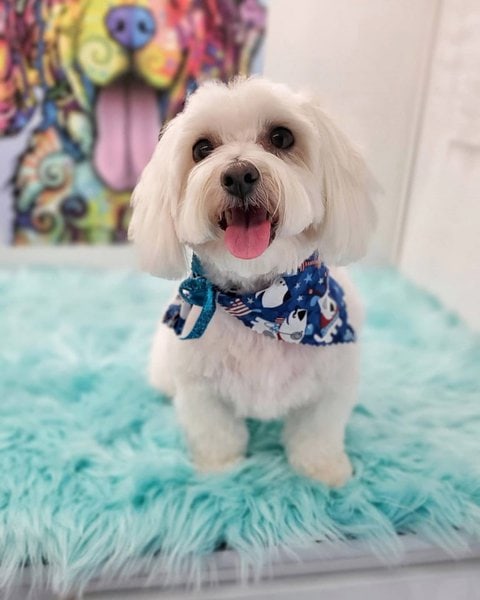
Expected Lifespan
With proper care and a healthy lifestyle, your Maltichon will end up living with you for a long time.
On average, Maltichons can live to as long as around 12 years, as benefits from the longevity of being a Maltese mix and a mixed breed.
However, it wouldn’t come off as a surprise if they ended up living for as long as 15 years. But, of course, in addition to lifestyle and care, genetics will also affect just how long your furry companion will live.
While there’s no way to guarantee the health of your doggie, most of the canine community agrees that the Maltichon is one of the healthier breeds. But, because these little white furballs are a mixed breed, it would help to pay close attention to signs and symptoms of issues that usually only affect either a Maltese and/or Bichon Frise.
These common health problems include the following:
Congenital Heart Defect / Patent Ductus Arteriosus
Due to genetic faults, Malteses are more at risk of having “Patent Ductus Arteriosus,” otherwise known as a congenital heart defect, compared to other dog breeds. But it’s not necessarily a death sentence. It is treatable, especially in younger dogs.
Kneecap Dislocation / Otherwise Known as Patellar Luxation
Maltese and other toy breed dogs are genetically predisposed to “patellar luxation,” otherwise more commonly known as kneecap dislocation. This is because the groove where the kneecap usually sits is much shallower. As a result, it’s more likely to slip out.
Cushing’s Disease
Cushing’s disease is the result of the body over-producing cortisol, which is a steroid hormone commonly associated with stress. In dogs, this can cause a number of complications, but mostly hair loss, usually on the body.
It’s relatively common among Malteses, but it is treatable.
Skin Issues and Allergies
Because the Maltichon usually gets their long yet single-layer coat of hair from their Maltese bloodline, they’re not as well-protected from environmental factors. This includes the sun, heat, and cold.
Hot and humid weather, in particular, can cause hot spots, which are skin lesions that can recur if not addressed properly.
Early Tooth Loss
It’s been proven that small dogs, and not just Maltichons specifically, are prone to early tooth loss. In fact, most small dogs tend to lose half their teeth by the time they are 10 years or older. But, there are ways around this, such as by brushing their teeth daily to prevent tartar formation.
We’d also like to remind you that the Maltichon is a mixed breed.
We say this because most of the common health problems associated with the Maltichon have a genetic component to them.
Bichon Frises, in particular, are known to have a high cancer rate.
We also suggest taking a close look at the parents of your Maltichon to see if they have any history of health complications so you might be able to better prepare yourself and your furry little friend for it when the time comes.
How To Take Care Of A Maltichon?
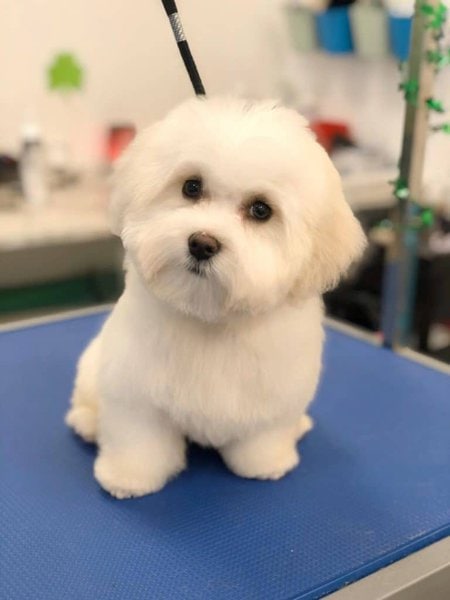
Grooming
You’ll have to be more hands-on with your Maltichon if you want to keep it well-groomed and healthy. This is because both of its parent breeds are known to need frequent baths, as often as once every three weeks, and the Maltichon is no different.
Exercise
Also, the Maltichon is the same as its parent breeds in that it is also a lapdog.
What this means is that the Maltichon does not require heavy exercise. But, even if that’s true, you’ll still want to give your Maltichon some playtime and exercise. However, at the same time, you shouldn’t let them play outside for too long.
More importantly, you’ll want to check in with your vet and make sure that your Maltichon is done with its puppy shots already before you let your little friend go outside.
Healthy Diet
Lastly, in terms of food, for a Maltichon, a healthy diet for small dog breeds is different from larger breeds. Naturally, it should contain an ideal mix of nutrients, vitamins, and minerals, as well as be properly formulated for smaller breeds. But, in general, you need to keep in mind that smaller breeds require more calories per pound compared to larger dogs.
“Complete and balanced” is a label that you’ll want to look for in readily available dog foods.
If, however, you prefer something just as convenient but, at the same time, also specifically designed for your dog’s breed, age, weight, allergies, and more, a healthy diet like Ollie might be worth taking a look at.
Just remember that its white coat and inherent genetics make it at risk for food-related allergies, so if your furry friend starts scratching more, you might want to start switching its food with something else.
Is A Maltichon Hypoallergenic? How Do You Groom A Maltese Bichon Frise?
We’ve got good news for you if you’re allergic to dogs.
The Bichon Frise and Maltese are known as hypoallergenic dogs. This means that these white-coated dogs are low-shedding, which also means that the resulting cross, the Maltichon, also benefits from this easy-breathing quality and that they’re less likely to cause allergies.
But, of course, it’s still important that you take good care of your Maltichon, especially its white coat.
For shaved and closely trimmed coats, especially puppies, we recommend brushing their hair often with a bristle brush. However, Maltichons with longer hair should be combed first before being brushed to check for tangles and matting.
To properly groom a Maltichon, we recommend having these accessories on hand.
Deshedding Brush
We strongly recommend the FURminator Deshedding Tool for your dog’s regular brushing routine.
The stainless steel comb can remove loose hair easily, as well as the undercoat, without damaging your furry companion’s coat or skin, and it comes with a “FURejector” button that lets you release any loose hair and undercoat with a literal push of a button.
Grooming Spray
To keep your Maltichon smelling good while leaving its coat softer, shinier, and easier to brush, we recommend the Lavender & Chamomile Aromatherapy Freshening & Shining Spray for Pets.
As an added bonus, this also doubles as a spray to help anxious and agitated pups calm down and is recommended by veterinarians.
Dog Shampoo
This hydrating and anti-fungal dog shampoo is a veterinary-recommended medicated shampoo free from parabens, dyes, and soap. This product also offers a pH-balanced treatment perfect for dogs with sensitive skin, including your Maltichon.
Temperament Of A Maltese Bichon Frise Mix
Bite-sized, fluffy, and white, the Maltichon isn’t just pure eye candy. The breed is also known for being affectionate and friendly.
Here are some answers to questions you might have about the Maltichon.
Do Maltichons Like to Be Held?
If you’ve noticed that your Maltichon just fawns over the idea of being held by you, then you’re not alone.
Maltichons love to cuddle, snuggle, and play, and they most definitely love being held by their owners.
Do Maltichons Love Their Owner?
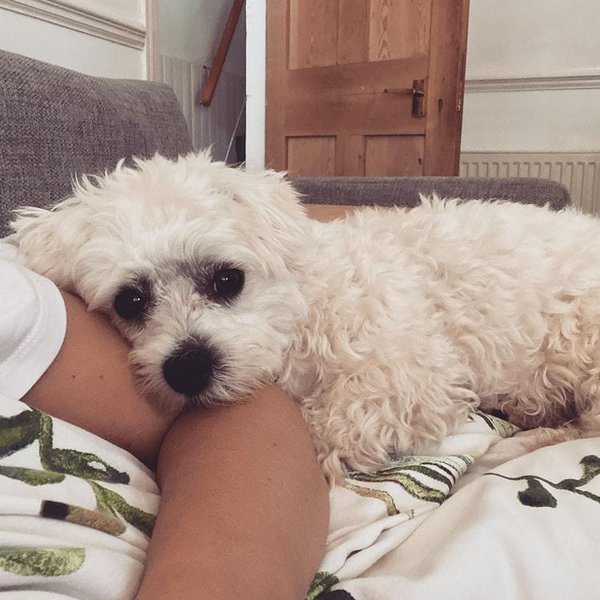
Yes, Maltichons love their owners.
Maltichons generally don’t want to spend their time alone, especially if it’s away from their owners.
Can You Leave a Maltichon Alone?
You can definitely leave your Maltichon alone. As a general rule of thumb, the number of hours you should leave your Maltichon alone should be based on their age in minds multiplied by one hour.
You should try not to leave your Maltichon, even if it’s fully grown, on its own for more than eight hours. If nothing else, your little friend will definitely miss having you around if you’re away from them for that long.
Do Maltichons Bark a Lot?
Yes, Maltichons are known to be barkers, and this behavior stems from the Maltese’s parentage. Although the Maltichon is a lap dog, it does have quite a lot of energy packed inside its miniature body.
Luckily, it is more than capable enough of expending its energy on its own without much effort or resorting to excessive barking or other destructive behaviors, like incessant chewing or licking. But, if you notice that your Maltichon is barking a lot, you’re either not playing with it enough or giving it enough time to drain its energy.
Related Questions
What Is The Price Of A Maltese Bichon Frise Mix? The price of a Maltese Bichon Frise Mix can range from anywhere between $450 to $1,500. The cost is usually determined if whether or not the Maltichon has had its initial set of puppy shots and a combination of the quality of its parents, as well as whether it comes from a legitimate and responsible breeder.
Are Maltichons Easy To Train? You’ll be happy to know that it’s actually quite easy to train a Maltichon. Both the Maltese and Bichon Frise are intelligent dog breeds. The Maltichon should be no different. But, for the best results, stick to short and challenging training sessions. Also, Maltichons might not be as easy to house train compared to other dog breeds.
Are Bichon Frise And Maltese Related? Yes, Bichon Frise and Maltese are related. Both the Maltese and the Bichon Frise share a canine group, lineage, and ancestors. Because of this, they have a lot in common. Here’s a fun fact. Both parent breeds are popular among royalty. Phoenicians, Greeks, and Romans, as well as Chinese royalty, have been historically proven to have favored the Maltese. Meanwhile, the Bichon Frise was a popular choice among aristocrats in Italy, Spain, and France for most of the 13th century and up until the 18th century.

